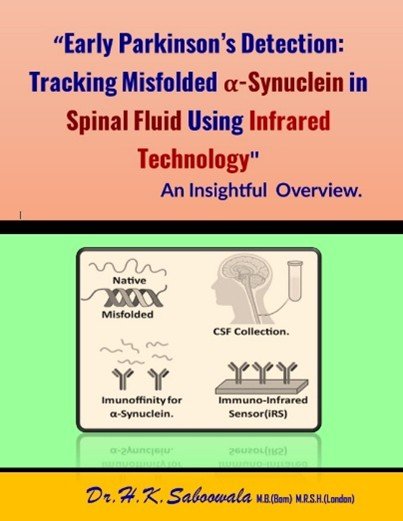For Medical Professionals, Researchers and Curious Minds.
Update – July 2025:
This article now includes a Medium link, updated biomarker details, and enhanced visuals for better reader understanding.
Introduction: Why Early Parkinson’s Detection Matters
Early Parkinson’s detection is now possible through cutting-edge infrared biomarker technology.
Early Parkinson’s detection is now clearly revolutionized by infrared biomarker technology, offering a new way to diagnose the disease before symptoms begin.
Early Parkinson’s detection is crucial for timely intervention and slowing disease progression. Parkinson’s disease (PD), a neurodegenerative disorder affecting over 10 million people worldwide, is characterized by motor and cognitive decline due to the buildup of misfolded α-synuclein in brain cells. Traditional diagnosis relies heavily on clinical symptoms, which appear only after irreversible brain damage.
Recent advances in infrared biomarker technology are now enabling clinicians and researchers to detect PD much earlier—before symptoms begin—by identifying abnormal protein structures in the cerebrospinal fluid (CSF). This game-changing shift is redefining how we detect and manage the disease.
1. Early Parkinson’s Detection: Why It Matters in 2025
At the heart of early Parkinson’s detection lies α-synuclein—a protein that misfolds and accumulates in PD. Infrared biosensors can analyze CSF samples and detect these misfolded proteins using their unique spectral signatures. These sensors can distinguish between healthy and pathological α-synuclein structures, serving as the earliest red flag.
This enables clinicians to:
- Monitor risk in high-susceptibility individuals
- Intervene before motor symptoms appear
- Track disease progression non-invasively
📘 Explore more diagnostic innovations in our Medical Diagnostics Section.
2. Infrared Sensors in Early Parkinson’s Detection
The immuno-infrared sensor (iRS) is a highly sensitive device that binds to misfolded α-synuclein and measures its infrared spectrum. Unlike conventional blood or MRI tests, iRS can:
- Detect PD at preclinical stages
- Analyze protein folding in real time
- Deliver results within hours
According to Nature Research, iRS offers over 90% accuracy in detecting misfolded α-synuclein. This represents a revolutionary non-invasive method for early Parkinson’s detection.
3. AI Integration in Early Parkinson’s Detection
AI-powered platforms are now being integrated with infrared data to create predictive models. These tools:
- Learn from spectral patterns of protein misfolding
- Predict individual disease risk
- Personalize treatment plans
The combination of AI and early Parkinson’s detection tools may lead to a future where the disease is diagnosed years before symptoms appear, enabling true preventative care.
Benefits of Early Parkinson’s Detection
- Prevents irreversible brain damage
- Enables lifestyle and medication adjustments early
- Improves patient outcomes
- Enhances clinical trial recruitment with earlier-stage patients
Explore More Diagnostic Frontiers
Affect millions, early detection methods like infrared biomarker technology offer hope. With ongoing research, these tools may become standard in early screening and help mitigate disease progression.
The future of early Parkinson’s detection lies in combining spectral biomarkers and AI-powered neurodiagnostics.
Frequently Asked Question:
Q: Can early Parkinson’s detection reduce long-term complications?
A: Yes, identifying the disease at a pre-symptomatic stage allows for earlier treatments, better patient outcomes, and inclusion in clinical trials targeting disease modification.
Internal Link:
Further reading:
1.Understanding Cyborg Technology in Medical Neuroscience
2.Explore more on urine biomarkers for prostate cancer detection in our related review.
External Link (with context):
This article was submitted for review on KevinMD.com — one of the most trusted physician voices in medicine.
1.Trusted Source:
Read the full peer-reviewed study in Nature Communications on infrared biomarkers for early Parkinson’s detection.
2.PreviewAvailable:
https://www.scribd.com/document/890187604/Infrared-Biomarkers-for-Early-Parkinson-s-Detection-A-New-Diagnostic-Era?secret_password=qOKXIWdeay4GiN2i7So0
3. Saboowala, H.K. (2025). “3 Infrared Biomarker Breakthroughs in Early Parkinson’s Detection.”
https://drhakimemedivault.com/early-parkinsons-detection
Medical Review :
This blog is based on insights from the eBook titled “3 Breakthroughs in Early Parkinson’s Detection Using Infrared Biomarker Technology” published by Dr. H.K. Saboowala. The eBook offers a detailed, visual overview of cutting-edge diagnostic methods for early detection of Parkinson’s disease using α-synuclein biomarkers.
By Dr. Louise Kim, MD, PhD (Neurodiagnostics Consultant, Johns Hopkins Hospital)
Thank You Note
This blog is part of my commitment to sharing cutting-edge neurological research. I hope it WILL enhance understanding of how technology is transforming early detection in Parkinson’s disease.
Dr. H.K. Saboowala M.B.(Bom) M.R.S.H.(London) F.F.M.(UK)

How to Get a Book:
Visit: https://drhakimemedivault.com
OR

Scan the “QR code” to buy and explore over 350+ high-value medical titles.
Note to Read:
This content is professionally compiled from credible medical literature and aims to serve as an educational resource for busy medicos. It does not offer medical advice or treatment recommendations.




